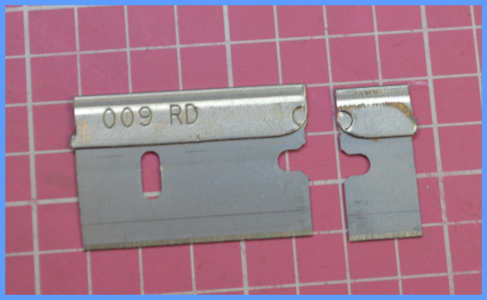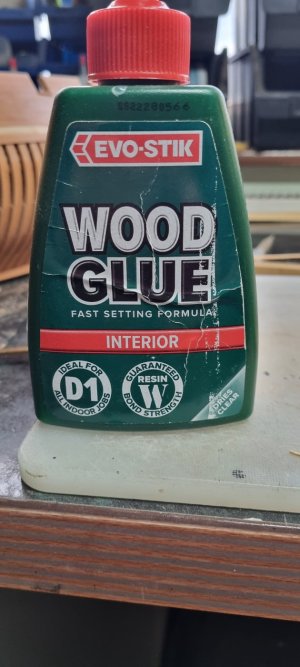-

Win a Free Custom Engraved Brass Coin!!!
As a way to introduce our brass coins to the community, we will raffle off a free coin during the month of August. Follow link ABOVE for instructions for entering.
You are using an out of date browser. It may not display this or other websites correctly.
You should upgrade or use an alternative browser.
You should upgrade or use an alternative browser.
- Joined
- Oct 9, 2020
- Messages
- 2,157
- Points
- 488

I hate to say this, but in my opinion, the only alternative is to sand that PVA. Fortunately it sands well. I had the same problem as yourself and that is all I could find to clean the joints.Having found nothing searching the forum, I'd appreciate some advice on removal of excess PVA glue squashed out of joints.
While wet, it's water soluble...but what to do if it is discovered when set or partially set. Thank you.
Last edited:
Sand, slice, or if needed, I believe you can soften it with heat.
- Joined
- Jun 29, 2024
- Messages
- 1,280
- Points
- 393

Denatured alcohol is a solvent for PVA glue. Brush some on and let it sit for a few minutes. It will get gummy and can be easily removed.
Roge,r
Roge,r
- Joined
- Apr 21, 2018
- Messages
- 824
- Points
- 353

Thanks for your input, guys.
'Slicing and dicing' has been the only way I've found; I was hoping for a softer solution, in a chemical sort of way.
I'm going to be building one of those 'FALCONET' 1:72 miniature boat kits.
I don't want to be using cyano, which gives off fumes that I'm sensitive to.
My only alternatives seem to be PVA, UHU, shellac or possibly seccotine.
Wetting/soaking/heating aren't options.
'Slicing and dicing' has been the only way I've found; I was hoping for a softer solution, in a chemical sort of way.
I'm going to be building one of those 'FALCONET' 1:72 miniature boat kits.
I don't want to be using cyano, which gives off fumes that I'm sensitive to.
My only alternatives seem to be PVA, UHU, shellac or possibly seccotine.
Wetting/soaking/heating aren't options.
Kurt Konrath
Kurt Konrath
As you said, easier to clean when new and wet, than sand, slice and scrape when it was dried.
- Joined
- Jun 29, 2024
- Messages
- 1,280
- Points
- 393

The Nitrocellulose adhesives are often overlooked. These are the old glues used to build balsa/tissue model airplanes. Here in the US they are sold by the brand names Duco and Ambroid. A close relative is the lacquer type clear fingernail polish. I keep both “in stock” on my workbench. They are quite effective at gluing wood to wood joints and in some cases with mechanical assistance will glue metal to wood. An example of this would be gluing a nail or piece of wire into a drilled hole. Acetone will dissolve hardened adhesive.
- Joined
- Jun 29, 2024
- Messages
- 1,280
- Points
- 393

My father and mother were married in 1932, the height of the depression. My father had just completed a degree in the new academic field of aeronautical engineering. The problem was that no one was hiring aeronautical engineers. To supplement the job that he did have they started the Viking Aircraft Co. to produce and sell model airplane kits designed by my father.
The kits were sold complete with glue, the Nitrocellulose type. It was easily homemade by dissolving celluloid plastic in acetone. The landlord that owned the house that they rented effectively closed the business because of the proximity of an open flame water to the volatile acetone!
Too bad that Brexit has not eased some of these restrictions.
Roger
The kits were sold complete with glue, the Nitrocellulose type. It was easily homemade by dissolving celluloid plastic in acetone. The landlord that owned the house that they rented effectively closed the business because of the proximity of an open flame water to the volatile acetone!
Too bad that Brexit has not eased some of these restrictions.
Roger
Who doesn't remember the smell of Ambroid ? I must have built a two hundred balsa model's when I was a kid 70 some odd years ago.
- Joined
- Oct 9, 2020
- Messages
- 2,157
- Points
- 488

that is the problem that I had. Acetone or nail polish remover and even alcohol fumes give me a headache if I am exposed to them for a long time.These celluloid products do degrade with time, are flamable and acetone is a proven carcinogen.
Just saying.....
So for me sanding was the best solution.
You may want to try UV setting glue for some of your applications. I find it works very well for a lot of areas where I would use CA.Thanks for your input, guys.
'Slicing and dicing' has been the only way I've found; I was hoping for a softer solution, in a chemical sort of way.
I'm going to be building one of those 'FALCONET' 1:72 miniature boat kits.
I don't want to be using cyano, which gives off fumes that I'm sensitive to.
My only alternatives seem to be PVA, UHU, shellac or possibly seccotine.
Wetting/soaking/heating aren't options.
Rob
- Joined
- Jul 18, 2024
- Messages
- 460
- Points
- 323

Here in Holland - sorry, the Netherlands - there’s no risk of kids sniffing model glue. Don’t ask.Thanks, Roger.
The Nitrocellulose adhesives are effectively banned in the UK (Global Warming, Nuclear Winter or kids sniffing the stuff etc).
Same for the paints.
- Joined
- Oct 9, 2020
- Messages
- 2,157
- Points
- 488

It happens everywhere. glue, gas, spray paint...Here in Holland - sorry, the Netherlands - there’s no risk of kids sniffing model glue. Don’t ask.
- Joined
- Apr 21, 2018
- Messages
- 824
- Points
- 353

Is this why the young no longer build models....no high anymore.
Maltby, you've surprised me, I wasn't aware of a choice of interior/exterior PVA.
Is there a difference in consistency and use?
Will my boat sink with one and not the other?
We're a strange lot here in South Yorkshire.
Maltby, you've surprised me, I wasn't aware of a choice of interior/exterior PVA.
Is there a difference in consistency and use?
Will my boat sink with one and not the other?
We're a strange lot here in South Yorkshire.
Last edited:





